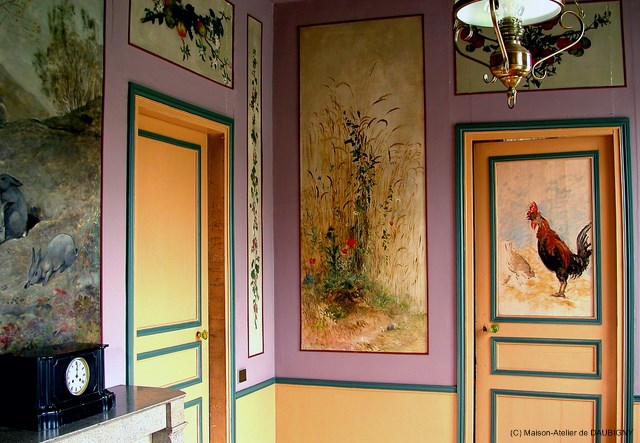The House
The first Artists' place birth
In 1860, Daubigny acquired land in Auvers-sur-Oise
He requested that the painter architect Oudinot, his friend, design his Studio House. Originally the house was planned to have two floors. Rooms to be lived in were fitted out on three sides of the studio. The latter will be opened to the outside thanks to a large plate-glass window.
He told his friend painter Henriet: "I bought a piece of land of 30 perches in Auvers, all covered in beans and on which I shall plant some legs of lamb if you come to see me, on which we are building a 8 x 6 meter studio, with some rooms all around. I hope to be able to use it by next Spring. Father Corot found Auvers very beautiful and suggested that I stay there part of the year".
"The house was built in 1861. It had finally only one single floor. The studio emerges from the building, as this room has not less than a 7m50 ridge height. The kitchen, the entrance and the dining room look out on a beautiful garden decorated with flowers in front of foliage of the Castle in the Vallées area.The first Artists' club was born ...
He requested that the painter architect Oudinot, his friend, design his Studio House. Originally the house was planned to have two floors. Rooms to be lived in were fitted out on three sides of the studio. The latter will be opened to the outside thanks to a large plate-glass window.
He told his friend painter Henriet: "I bought a piece of land of 30 perches in Auvers, all covered in beans and on which I shall plant some legs of lamb if you come to see me, on which we are building a 8 x 6 meter studio, with some rooms all around. I hope to be able to use it by next Spring. Father Corot found Auvers very beautiful and suggested that I stay there part of the year".
"The house was built in 1861. It had finally only one single floor. The studio emerges from the building, as this room has not less than a 7m50 ridge height. The kitchen, the entrance and the dining room look out on a beautiful garden decorated with flowers in front of foliage of the Castle in the Vallées area.The first Artists' club was born ...
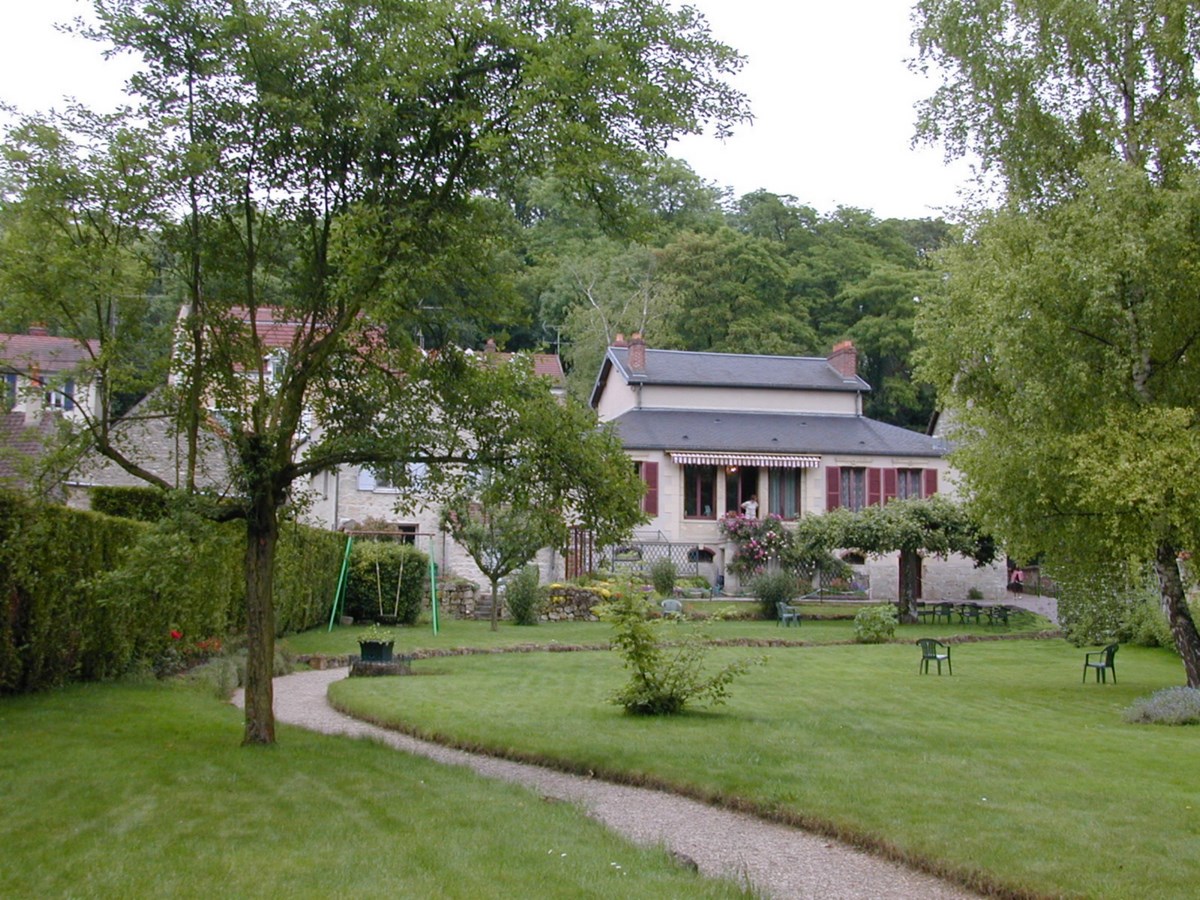
The Studio-House
Cécile's bedroom
In 1863, for his daughter Cécile’s twentieth birthday, Charles-François began to decorate her bedroom by designing a frieze made of twenty different flower crowns.
The alcove is just a nice blossoming shrub occupied by busy tits.
Cécile decorated the bottom of the castanets with a bouquet full of freshness, and little Bernard, 10 years old, painted a cherry tree branch with twenty cherries.
The alcove is just a nice blossoming shrub occupied by busy tits.
Cécile decorated the bottom of the castanets with a bouquet full of freshness, and little Bernard, 10 years old, painted a cherry tree branch with twenty cherries.

Poppy crown
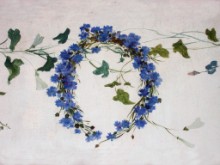
Cornflower blue crown
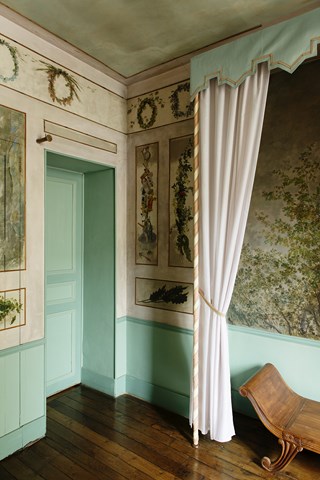
Cécile's bedroom - © Colombe Clier MCC
Then charles François Daubigny added murals recalling Cécile's childhood: illustration of narratives (Little Thumb, The fox and the raven, Little Red Riding Hood), representation of usual games (badminton, castanets, game of grace ...).
He also painted her piano along with a few flowered branches
He also painted her piano along with a few flowered branches
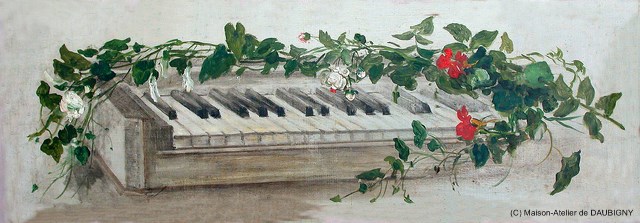
Cécile's piano

The fox and the raven

Game of Grace
The Lobby

The lobby with a view of the dining room - © Colombe Clier MCC
After Daubigny decorated Cécile’s bedroom, his friends, among them Corot and Daumier, suggested that this Studio House be decorated.
Corot decided to beautify the lobby, and he created 5 paintings, now scattered around the world.
Daumier painted the “Don Quixote, Sancho Pansa and the Dead Mule” now at the Museum d’Orsay, in Paris.
A copy is now standing on the wall located to the right of the dining room door, whereas it was on the left hand side originally.
Corot decided to beautify the lobby, and he created 5 paintings, now scattered around the world.
Daumier painted the “Don Quixote, Sancho Pansa and the Dead Mule” now at the Museum d’Orsay, in Paris.
A copy is now standing on the wall located to the right of the dining room door, whereas it was on the left hand side originally.
The Studio
Corot designed the Studio decoration (today these design sketches are found in the collection of the Museum of Baltimore).
In their idle moments, mainly the rainy days when it was not possible to go outside to paint, Daubigny and their friends worked on the decoration inside the studio. They reproduced the drawings designed by Corot on not less than 100m² of canvas glued on the walls. Oudinot, the architect, but also an occasional painter, designed the wooden sculptured fireplace and overdoors.
Not less than 10 years were required for this gifted team to complete the decoration of the studio.
Charles-François' children, Cécile and Karl, were also involved in this group effort. Karl painted the upper sides of the room and also contributed the 350 motifs of the friezes, which he did freehand!
In their idle moments, mainly the rainy days when it was not possible to go outside to paint, Daubigny and their friends worked on the decoration inside the studio. They reproduced the drawings designed by Corot on not less than 100m² of canvas glued on the walls. Oudinot, the architect, but also an occasional painter, designed the wooden sculptured fireplace and overdoors.
Not less than 10 years were required for this gifted team to complete the decoration of the studio.
Charles-François' children, Cécile and Karl, were also involved in this group effort. Karl painted the upper sides of the room and also contributed the 350 motifs of the friezes, which he did freehand!
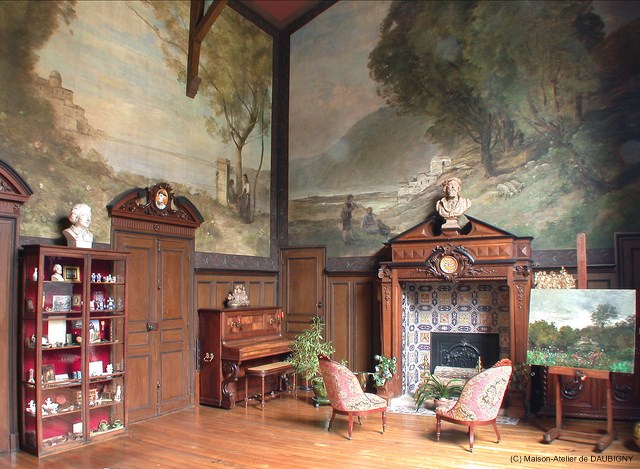
The Studio


